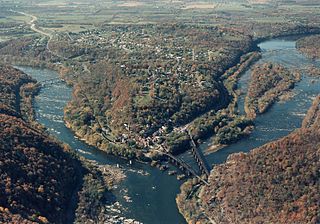| Brandywine Creek (Quittapahilla Creek) | |
|---|---|
| Location | |
| Country | United States of America |
| Physical characteristics | |
| Source | |
| - coordinates | 40°22′10″N76°23′43″W / 40.36944°N 76.39528°W [1] |
| Mouth | |
- location | Quittapahilla Creek |
- coordinates | 40°20′17″N76°26′10″W / 40.33806°N 76.43611°W Coordinates: 40°20′17″N76°26′10″W / 40.33806°N 76.43611°W [1] |
- elevation | 456 ft (139 m) [1] |
Brandywine Creek [2] is a 3.0-mile-long (4.8 km) [3] tributary of Quittapahilla Creek in Lebanon County, Pennsylvania, in the United States.

A tributary or affluent is a stream or river that flows into a larger stream or main stem river or a lake. A tributary does not flow directly into a sea or ocean. Tributaries and the main stem river drain the surrounding drainage basin of its surface water and groundwater, leading the water out into an ocean.
Quittapahilla Creek is a 16.8-mile-long (27.0 km) tributary of Swatara Creek in south-central Pennsylvania in the United States. The original Lenape name for this waterway is Kuwektəpehəle, which means 'it flows out (ktəpehəle) from the pines (kuwe)'.

LebanonCounty is a county located in the U.S. state of Pennsylvania. As of the 2010 census, the population was 133,568. Its county seat is Lebanon. The county was formed from portions of Dauphin and Lancaster counties in 1813, with minor boundary revisions in 1814 and 1821. Lebanon County comprises the Lebanon, Pennsylvania, Metropolitan Statistical Area, which is also included in the Harrisburg-York-Lebanon, Pennsylvania Combined Statistical Area. Lebanon is 72 miles northwest of Philadelphia, which is the nearest major city.
Contents
It rises in northeastern Lebanon County and flows southwest through Lebanon, through the limestone hill country south of the Appalachian Mountains. It joins Quittapahilla Creek west of the center of Lebanon.

Lebanon is a city in and the county seat of Lebanon County, Pennsylvania, United States. The population was 25,477 at the 2010 census, a 4.2% increase from the 2000 count of 24,461. Lebanon is located in the central part of the Lebanon Valley, 26 miles (42 km) east of Harrisburg and 29 miles (47 km) west of Reading.

Limestone is a carbonate sedimentary rock that is often composed of the skeletal fragments of marine organisms such as coral, foraminifera, and molluscs. Its major materials are the minerals calcite and aragonite, which are different crystal forms of calcium carbonate (CaCO3). A closely related rock is dolostone, which contains a high percentage of the mineral dolomite, CaMg(CO3)2. In fact, in old USGS publications, dolostone was referred to as magnesian limestone, a term now reserved for magnesium-deficient dolostones or magnesium-rich limestones.

The Appalachian Mountains, often called the Appalachians, are a system of mountains in eastern North America. The Appalachians first formed roughly 480 million years ago during the Ordovician Period. They once reached elevations similar to those of the Alps and the Rocky Mountains before experiencing natural erosion. The Appalachian chain is a barrier to east–west travel, as it forms a series of alternating ridgelines and valleys oriented in opposition to most highways and railroads running east–west.
Stovers Dam 40°21′13″N76°24′38″W / 40.35361°N 76.41056°W [4] and Recreation Area is the principal landmark along Brandywine Creek.













